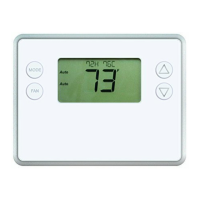24 Copyright © 2016 Broan-NuTone LLC
Specications
Power
C-Wire Input: 20-30VAC
Baery Power: 4 AA Baeries
Operating Temperature
32° to 120°F (0° to 49°C)
Storage Temperature
-40° to 140°F (-40° to 60°C)
Messaging Capability
7 character alpha numeric display, with message scroll
Set-point Accuracy
1° F (0.5°C), Calibrates to +/- 7°F
Ambient Temperature Display
Accuracy
1° F (0.5°C)
Remote Control
Via Z-Wave
Standard Gas/Electric HVAC
Systems
2-stage heang, 2-stage cooling
Heat Pump HVAC System
3-stage heang, 2-stage cooling
Thermostat Connections
Uses standard thermostat connecons (C,RC,RH,W1,W2/O,Y1,Y2,G) -
18 AWG
Regulator
United States: FCC Compliant to CFR47, Part 15B Canada: Industry
Canada RSS 210, Issue 8
Dimensions
5.75” (146mm) W, 4.5”(114.3mm) H, 1.00 (25.4mm) D
Screen Size
2.7” X 1.4” LCD w/white backlight (68.6mm X 35.6mm)
Buttons
4 mechanical buons (Mode, Fan, Up Arrow, Down Arrow)
Certication
FCC Part 15, Industry Canada
Regulatory Information
FCC ID: WIBTZW011
This device complies with Part 15 of the FCC Rules. Operaon is subject to the following two
condions: (1) This device may not cause harmful interference, and (2) This device must accept any
interference received, including interference that may cause undesired operaon.
This equipment has been tested and found to comply with the limits for Class B Digital Device,
pursuant to Part 15 of the FCC Rules. These limits are designed to provide reasonable protecon
against harmful interference in a residenal installaon. This equipment generates and can radiate
radio frequency energy and, if not installed and used in accordance with the instrucons, may cause
harmful interference to radio communicaons. However, there is no guarantee that interference will
not occur in a parcular installaon. If this equipment does cause harmful interference to radio or
television recepon, which can be determined by turning the equipment o and on, the user is
encouraged to try to correct the interference by one or more of the following measures.
• Reorient or relocate the receiving antenna
• Increase the separaon between the equipment and receiver
• Connect the equipment into an outlet on a circuit dierent from that to which the receiver is
connected
• Consult the dealer or an experienced radio/TV technician for help
Any changes or modicaons not expressly approved by the party responsible for compliance could
void the user’s authority to operate the equipment.

